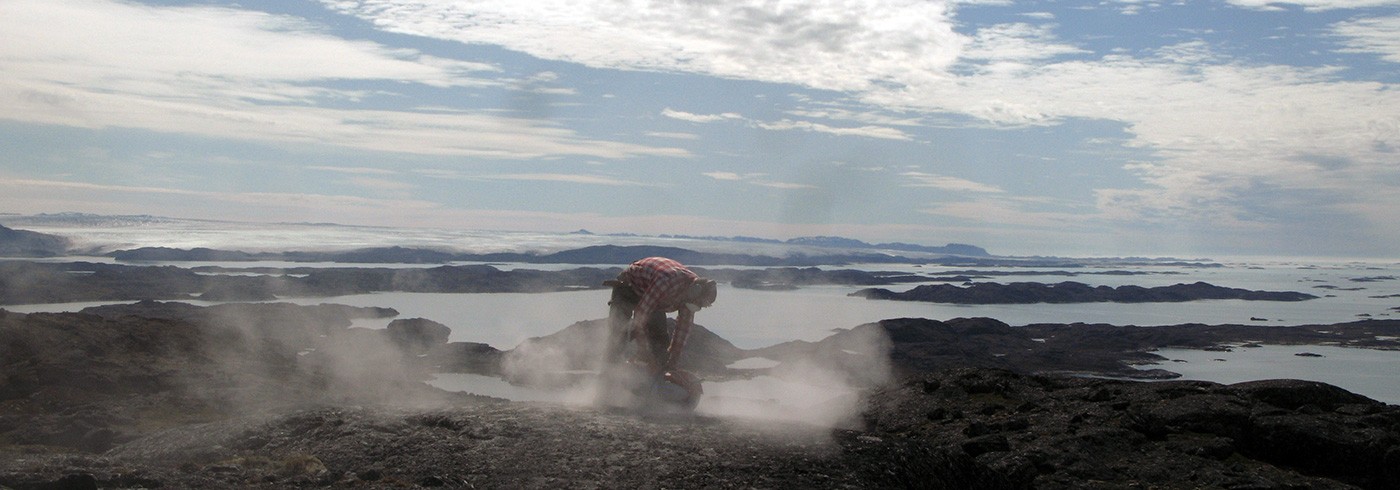Past impact of warming on the Greenland Ice Sheet – second field season
1 June 2009 - 1 July 2009The objective of this project is to investigate how the ice margin of the Greenland Ice Sheet reacted to earlier periods of warming, the interrelationship between sea-ice and sea-level changes and furthermore, to ascertain how such changes have affected human adaptation and migration. This research is part of the Danish-led RINK project – Respons af Indlandsisen til Naturlige Klimaændringer.
The activities reported here are from the second field season within the RINK project in southernmost Greenland. The main purpose was to core threshold lakes and collect rock samples for cosmogenic exposure dating, from high altitude bedrock and erratics, in a 100 km transect from nunataks to the outer coast and from moraines. Greatest effort was applied to coring threshold lakes, which record glacial advances of the Greenland Ice Sheet by changes in sedimentation: from gyttja to more minerogenic sediments. A special focus was accorded the timing of the Little Ice Age (LIA, 16th–19th century) along the southernmost part of the Greenland Ice Sheet. This region is known for its vigorous response to climate change, such as the Little Ice Age and the recent warming in the 20th and 21st century. Another important component of the project is to look for ancient DNA in lake archives from the last 10,000 years, in order to gain more knowledge about past environmental changes. The set of exposure dates is – together with the samples collected last year – intended to give an overall estimate of the thinning and recession of the ice margin during the last 10,000 years. Other objectives were to locate marine and lacustrine sedimentary archives and map landforms indicative of glacial erosion and sediment accumulation.

Cutting samples for cosmogenic exposure dating with rock saw at Ravns Storø. The ice lobe in the background is Frederikshåb Isblink. Photo: Nicolaj Krog Larsen
Fieldwork
During five weeks from mid-June to mid-July, we worked in two areas in south and southwest Greenland around Narsarssuaq and Fiskenæsset. We were transported by helicopter, which meant that the equipment had to be kept at a minimum. Our main study sites were located around the threshold lakes, which were selected from satellite imagery and aerial photographs. We used a large Uwitech platform to core the large lakes, and a Russian sampler and a modified dagnowski corer on the smaller lakes. Both coring systems were successful: a total of seven lakes were cored and nearly 50 m of sediment was obtained. In addition we used a vibrocore system to core aeolian sediments around Søndre Igaliku – a place known for its many ruins dating from the Norse settlements. Rock samples were cut out of erratic boulders and bedrock using a saw. This turned out to be more efficient than using hammer and chisel as we did last year, but it had the disadvantage of being heavy work and producing a lot of quartz dust.

Sediment core from a small lake in southern Greenland close to Narsarsuaq. The marked shift from gyttja to silty clay in the top of the core reflects the LIA advance
of the Greenland Ice Sheet. Samples are sub-sampled for radiocarbon dating. Photo: Nicolaj Krog Larsen
Outcome and further work
After returning the cores to Lund and Copenhagen, they were opened and scanned for Xray fluorescence and magnetic susceptibility. They were then sub-sampled for radiocarbon dating, ancient DNA and other analysis that will provide us with better knowledge about how the Greenland Ice Sheet and the environment responded to past climate changes. The exposure samples have been sent to Purdue Rare Isotope Measurement Laboratory in USA were they will be processed and dated, and we expect to receive preliminary dates at the end of 2010. The new data will hopefully give us a better understanding of the retreat and thinning of the Greenland Ice Sheet during the last deglaciation and over a longer time-scale of 10,000 years. This information can be used to obtain an appreciation of how the ice sheet may respond to the present global warming.









